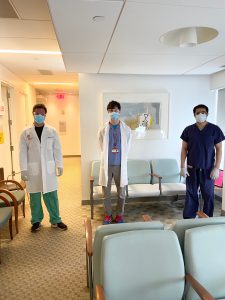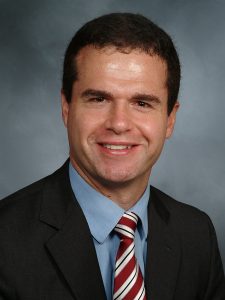This issue of RetinaLink’s Staying the Course features Dr. Anton Orlin, Associate Professor of Ophthalmology at Weill Cornell Medical College and Attending Physician at the New York Presbyterian Hospital, in New York, NY. New York City has been the epicenter for COVID-19 in the United States. Today, Dr. Orlin contributes his account of this ongoing pandemic and working on the front line at Weill Cornell.
Weill Cornell Medical College (WCMC) and the New York Presbyterian (NYP) Hospital are at the forefront of the pandemic fight in New York City. There are roughly 2,400 COVID-19 patients admitted to the system with 600 patients in the ICU. In addition to providing care for ophthalmic emergencies, the department has also joined the hospital in its fight against coronavirus. Ophthalmology attendings, fellows, residents and nurses have been deployed to where they are needed most, such as the Emergency Room, Workforce Health, and ICU. The operating rooms in our surgery center were closed and immediately converted to ICU beds with ventilators, to accommodate COVID-19 patients during the surge. We still have a couple remaining OR rooms, which are reserved for emergencies, to allow us to continue providing necessary care to our patients.
During this crisis, communication has been mission-critical and our leadership has been remarkable. We have weekly meetings with both our Dean and Chairman, Dr. Donald J. D’Amico. We are all part of the same team at WCMC/NYP, and I’m fortunate to be in such a great department where everyone is eager to help in any way they can.
RetinaLink (RL): Please outline what patients you are seeing in your clinic.
Anton Orlin, MD (AO): The Weill Cornell Ophthalmology Department has only seen emergent and urgent patients as outlined by the AAO and ASRS Guidelines since mid-March. In the retina clinic, this includes injection patients, recent post ops, and anyone with new or worsening symptoms consistent with an emergency, such as a detachment. Surgical cases need to be approved by an ethics committee, and urgent cases include acute retinal detachment, intraocular foreign bodies, or progressing traction detachments. We’ll also operate sooner on monocular patients for other etiologies and each is case dependent.
To concentrate our resources, and to ensure the safety of our patients and staff, we are only seeing patients at our main office location on the Upper East Side, and have closed many of our satellite offices. I’ll go through the weekly schedule in advance, and adjust it accordingly with my secretary, to ensure that we see the urgent patients while rescheduling the others. My patient volume is now around 15-20%. Often times, patients still postpone these recommended exams and injections, due to their concern of contracting COVID-19 given the high prevalence in NYC. Many of our patients are elderly or have comorbidities such as diabetes, and are considered to be at risk of developing severe from COVID-19. The number of patient phone calls has increased given the uncertainty that we are all facing, and it is important to address them in a timely fashion to maintain a level of trust and care with each patient.
RL: What is your new patient protocol upon arriving at your clinic?
AO: When possible, we have patients come alone to their visits, to decrease the number of people in our waiting area. If a caregiver is necessary, we try to limit it to one person. All staff wear masks and gloves, while physicians also wear goggles during each patient visit. My administrative assistant does the initial COVID-19 screening via a phone call. Then, our front desk staff and physician assistants further screen the patient once he/she arrives for any concerning COVID-19 symptoms. Almost all of our patients wear masks. We limit the exam and imaging to the essentials to ensure patients are managed efficiently to protect them, the staff and physicians. After a patient is seen, the room is immediately cleaned thoroughly.
There is a designated exam room to isolate potential COVID positive patients. Any staff entering the room wears full PPE. Based on the symptoms and comorbidities (established WCMC protocol) the patient is grouped into low, moderate or high risk, determining what further action is necessary.

(L to R) Dr. Anton Orlin and Senior
Vitreoretinal Fellows Dr. Kyle Kovacs
and Dr. Luis Gonzalez
I also see NICU babies once a week for screening and potential treatment of ROP. Recently, it has been particularly busy, although I do not think it is connected to COVID-19. During rounds, I limit the staff to our ROP nurse, and no longer have a fellow join for these exams. Again, we try to limit exposure to the babies, NICU staff, and ourselves by being efficient. In addition to wearing masks and goggles, I also wear a gown for each exam, per our NICU protocol at NYP.
RL: What have you been doing to decompress after your long and busy days?
AO: My wife and I are expecting our first child later this summer, so we are spending a lot of quality time together, trying to get in as much rest as possible before the baby comes. Although we miss going to restaurants, we have also been testing out some new recipes, and balancing it all by continuing to stay active and streaming workout classes. To stay productive outside of the office, I am staying busy with administrative responsibilities as the Vitreoretinal Fellowship Director at Cornell and with the Vit-Buckle Society.
I would like to take this opportunity to express my thanks to everyone at NYP, Cornell, and our department; including nurses, technicians, secretaries, front desk staff and trainees. They have worked tirelessly to ensure things are made safer for our patients and us.
Dr. Orlin can be reached via e-mail – [email protected]

